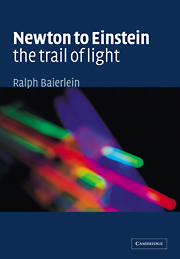 Newton to Einstein: The Trail of Light
Newton to Einstein: The Trail of Light Published online by Cambridge University Press: 05 June 2012
It is clear that the X-rays thus scattered proceed in direct quanta of radiant energy; in other words, that they act as photon particles. … Time does not permit me to review the evidence that was accumulating in the meantime that gave full support likewise to the electromagnetic wave character of the X-rays. … It became evident that though X-rays moved and did things as particles, they nevertheless have also the characteristic optical qualities that identify them as waves.
A. H. Compton, 1961, recalling the events of the decade 1915–25.Hertz revisited
In chapters 5 and 6, we noted that Heinrich Hertz discovered the photoelectric effect while investigating electromagnetic waves. A strong spark produces not only visible light but also ultraviolet light. When ultraviolet light from a spark in Hertz's transmitter circuitry struck the metal of his detector, the ultraviolet ejected some electrons. Those electrons, now present in the gap across which a spark was to jump, made it easier for a spark to jump. After all, a spark is an electric current, and the presence of the ejected electrons gave the spark a head start (for air is ordinarily a poor conductor of electricity, having few mobile charged particles). What Hertz perceived directly was that, when ultraviolet light shone on the detector, the spark was easier to start and could be made to jump a larger gap.
This was fascinating, and Hertz did spend six months establishing conclusively the essential role of ultraviolet light, but then he returned to electromagnetic waves.
To save this book to your Kindle, first ensure [email protected] is added to your Approved Personal Document E-mail List under your Personal Document Settings on the Manage Your Content and Devices page of your Amazon account. Then enter the ‘name’ part of your Kindle email address below. Find out more about saving to your Kindle.
Note you can select to save to either the @free.kindle.com or @kindle.com variations. ‘@free.kindle.com’ emails are free but can only be saved to your device when it is connected to wi-fi. ‘@kindle.com’ emails can be delivered even when you are not connected to wi-fi, but note that service fees apply.
Find out more about the Kindle Personal Document Service.
To save content items to your account, please confirm that you agree to abide by our usage policies. If this is the first time you use this feature, you will be asked to authorise Cambridge Core to connect with your account. Find out more about saving content to Dropbox.
To save content items to your account, please confirm that you agree to abide by our usage policies. If this is the first time you use this feature, you will be asked to authorise Cambridge Core to connect with your account. Find out more about saving content to Google Drive.